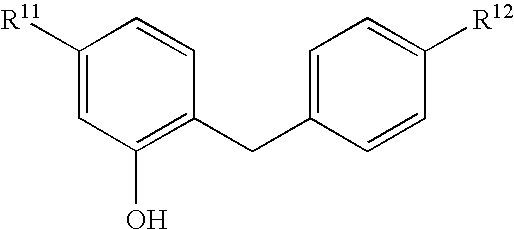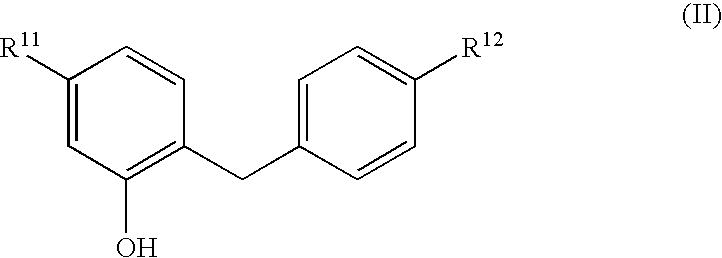Glucopyranosyloxybenzylbenzene derivatives, medicinal compositions containing the same and intermediates for the preparation of the derivatives
a technology of glucopyranosyloxybenzene and derivatives, which is applied in the field of glucopyranosyloxybenzene derivatives, can solve the problems of occasional adverse effects of biguanides and sulfonylureas, control and continuous performance, etc., and achieve excellent inhibitory activity in human sglt2 and potent inhibitory activity in human sglt2
- Summary
- Abstract
- Description
- Claims
- Application Information
AI Technical Summary
Benefits of technology
Problems solved by technology
Method used
Image
Examples
reference example 1
4-(3-Benzyloxypropyl)bromobenzene
[0035]A suspension of sodium hydride (60%, 0.97g), 3-(4-bromophenyl)-1-propanol (1.0 g) and benzyl bromide (0.69 mL) in benzene (24 mL) was stirred for 7 hours under reflux. After cooling to ambient temperature, a saturated aqueous ammonium chloride solution (50 mL) was added to the reaction mixture, and the mixture was extracted with ethyl acetate (100 mL). The organic layer was washed with water (40 mL) and brine (40 mL), and dried over anhydrous sodium sulfate. The solvent was removed under reduced pressure, and the residue was purified by column chromatography on silica gel (eluent: hexane / ethyl acetate=20 / 1) to give 4-(3-benzyloxypropyl)bromobenzene (1.4 g).
[0036]1H-NMR (CDCl3) δ ppm: 1.85–2.00 (2H, m), 2.60–2.75 (2H, m), 3.47 (2H, t, J=6.2 Hz), 4.50 (2H, s), 7.00–7.10 (2H, m), 7.20–7.45 (7H, m)
reference example 2
Methyl 4-(4-ethylbenzyl)-3-hydroxybenzoate
[0037]To a solution of 1-bromo-4-ethylbenzene (0.41 mL) in tetrahydrofuran (15 mL) was added 1.45 mol / L tert-butyllithium n-pentane solution (2.3 mL) under an argon atmosphere at −78° C. After the mixture was stirred at −78° C. for 10 minutes, a solution of methyl 4-formyl-3-hydroxybenzoate (0.18 g) in tetrahydrofuran (5 mL) was added to the reaction mixture. After the mixture was stirred under ice-cooling for 45 minutes, a saturated aqueous ammonium chloride solution and water were added to the reaction mixture, and the mixture was extracted with ethyl acetate. The extract was washed with water and dried over anhydrous magnesium sulfate, and the solvent was removed under reduced pressure. The residue was purified by column chromatography on silica gel (eluent: hexane / ethyl acetate=3 / 1) to give a diphenylmethanol compound (0.27 g). The obtained diphenylmethanol compound (0.27 g) was dissolved in methanol (5 mL), and concentrated hydrochloric...
reference example 3
Methyl 3-hydroxy-4-(4-propoxybenzyl)benzoate
[0039]To a solution of 1-allyloxy-4-bromobenzene (3.1 g) in tetrahydrofuran (70 mL) was added 1.45 mol / L tert-butyllithium n-pentane solution (11 mL) under an argon atmosphere at −78° C. After the mixture was stirred at −78° C. for 5 minutes, a solution of methyl 4-formyl-3-hydroxybenzoate (0.89 g) in tetrahydrofuran (15 mL) was added to the reaction mixture. After the mixture was stirred for 30 minutes under ice-cooling, a saturated aqueous ammonium chloride solution and water were added to the reaction mixture, and the mixture was extracted with ethyl acetate. The extract was washed with water and dried over anhydrous magnesium sulfate, and the solvent was removed under reduced pressure. The residue was purified by column chromatography on silica gel (eluent: hexane / ethyl acetate=3 / 1) to give a diphenylmethanol compound (0.99 g). The obtained diphenylmethanol compound (0.99 g) was dissolved in methanol (10 mL), and 10% palladium-carbon p...
PUM
 Login to View More
Login to View More Abstract
Description
Claims
Application Information
 Login to View More
Login to View More - R&D
- Intellectual Property
- Life Sciences
- Materials
- Tech Scout
- Unparalleled Data Quality
- Higher Quality Content
- 60% Fewer Hallucinations
Browse by: Latest US Patents, China's latest patents, Technical Efficacy Thesaurus, Application Domain, Technology Topic, Popular Technical Reports.
© 2025 PatSnap. All rights reserved.Legal|Privacy policy|Modern Slavery Act Transparency Statement|Sitemap|About US| Contact US: help@patsnap.com



